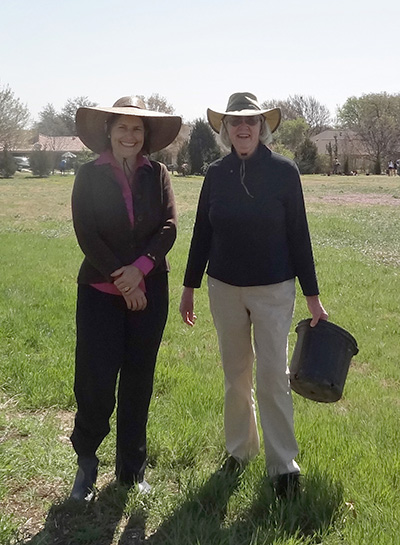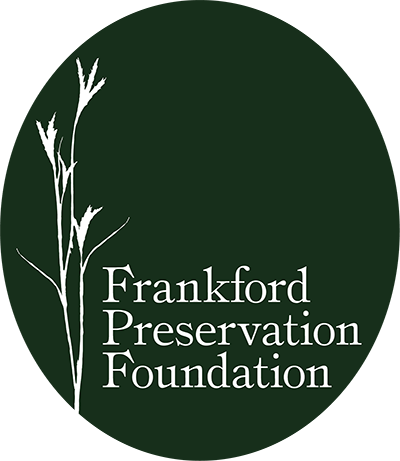Discovery of Frankford Prairie
On a blisteringly hot day in August 2009, landscape architect Rosa Finsley came to the Frankford site to talk about creating a native landscape around the old Frankford Church. During her initial visit Rosa observed some rare native plants in the recently mowed fields between the church and cemetery. Intrigued, she continued to study the fields during the nine-month church restoration.
To listen to the audio version of the text below press play.
In late May 2010 Rosa approached me about discontinuing the mowing of parts of our fields “just to see what might come up.” We selected a portion of our west meadow not far from the church to begin our experiment. In short order, plants of all kinds pushed their way through the black soil.
As our experiment continued we noticed a significant number of non-native plants encroaching on the native plants. Rosa advised that if we did not remove the non-natives the project would not be successful. Two excellent helpers, trained by Rosa, and I worked most Fridays and Saturdays for three years during the growing season removing plants that Rosa had identified as non-natives and undesirable. Neighbors who walked our site wondered what on earth we were doing.

In late June 2010 while removing non-natives my co-workers and I noticed a new grass distinctly different from others in the meadow. It had rich, waxy, bluish-green, long blades that arced out to the ground in a circular pattern. Standing in the middle of the meadow I called Rosa and described this “new” plant. “Should we pull it, Rosa?” Her reply: “I’m not sure what you are describing but don’t touch it until I return to Frankford.”

Kathy Power and Rosa Findley
About two weeks later, on a late Sunday afternoon, Rosa and I met at Frankford and I showed her the unidentified plants. By that time they had sent up seed stalks the tops of which looked like turkey feet. Rosa gasped. “This is big blue stem,” she replied. She explained that big blue stem is one of the “Big Four” grasses of the Blackland Prairie which can grow up to eight feet tall. It is unusual to find it indigenous to an urban site today. There it was, however—a solid mass of big blue, sturdy and green despite the intense heat and drought. It seemed delighted we had given it a chance to grow after so many years of mowing.
It was at that moment, with the setting summer sun casting its light on our west meadow that Rosa knew what we had was “the real deal.” Under Rosa’s guidance my helpers and I continued our work reinvigorated and with a new-found sense of purpose. All the while, the plants, native and not, continued to come up. Still today it is hard to describe my feelings during those amazing first years of work in the prairie. It was, as naturalist Matt White has said, like discovering a lost world. We forged on.
As the native plants sprang up all around us and we continued to pull the non-natives, I wondered about the history of the Frankford site. Could it be that this little patch of prairie existed because it had escaped the plow in some miraculous way? The historic deeds for the church site held some of the answers.
In 1852 W. C. (Captain) McKamy bought land from Peters Colonists in what is now southern Collin County and northern Dallas County. This land included Indian Springs on the banks of a tributary of White Rock Creek. On the site was an area still referred to today as “the wagon yard.” Native Americans camped there as early as the 1400s and settlers parked their covered wagons on that spot in the mid-1800s. Captain McKamy sold firewood and drinking water to the settlers that camped near Indian Springs.
Eventually, the town of Frankford grew around the everlasting springs. At the end of their lives, residents of the tiny community were laid to rest under the prairie grasses, thus beginning the formation of Frankford Cemetery.
In September 1873, Captain McKamy sold five acres east of the creek and Indian Springs to the White Rock Masonic Lodge for the building of a church. It is possible that McKamy was willing to sell the five acres to the Lodge because the limestone was so close to the surface and unsuitable for farming but would provide a solid foundation for a church. He and his wife, Rachel, were devout Methodists who held services in their home in the early years of Frankford.
Captain McKamy had not tilled that five-acre tract since he had bought it in 1852 and between 1873 and 2010 no one else broke ground on it. Starting in probably the late 1940s the site was mowed sporadically for events like Decoration Day. Though the tract was mowed, it was never plowed and the roots of its ancient plants lay under the surface until 2010 when they were finally given an opportunity to grow once again.
In May 2011, as I addressed the Decoration Day crowd in the little church, I saw through the windows an unfamiliar man in his Sunday suit walking through the prairie. After the service I met this man. Rich Jaynes, native Blackland Prairie enthusiast and teacher, was fascinated by our prairie remnant. Before he left that day he implored me to allow the east meadow to grow. We did just that.
In early March 2012, photographer David Rogers, who had been taking pictures for a Frankford brochure, called me. “Have you been to Frankford lately?” I could sense the excitement and urgency in his voice. “The east meadow is covered with light blue flowers. You must come at once.” I hurried to Frankford where I found the east meadow awash in light lilac flowers that clung to seed stalks rising about a foot from the ground. Each plant by itself was beautiful. The hundreds, perhaps thousands grouped together were spectacular.
This newly discovered plant was soon identified as Camassia scilloides, or wild blue hyacinth. It is rather unusual to find it in abundance in North Texas but is sometimes found on limestone prairies, like the Frankford Prairie.
The discovery of big blue stem at Frankford convinced Rosa that we had a genuine remnant of prairie at Frankford while the emergence of the wild blue hyacinths convinced some of the neighbors that this puzzling project could have some merit. Seven years after their re-appearance the hyacinths each spring have become a greatly anticipated event. Neighbors and visitors from all over the Dallas area come to enjoy the fragile beauty of these remarkable flowers.
After the discovery of the Frankford Prairie we opted for a path we had not expected when we embarked on the restoration of the church. I am deeply grateful to the Frankford Cemetery Association, the newly formed Frankford Preservation Foundation, Rosa Finsley, Rich Jaynes, Matt White and his family, countless master naturalists, historians and prairie tour enthusiasts. Your steady support, work and encouragement make us realize we chose the right path. In the words of Robert Frost, “It has made all the difference.”
Kathy Power
President
Frankford Preservation Foundation
